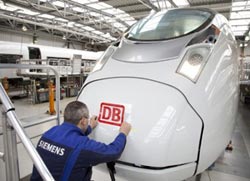Fast and Frugal: Trains with New Technology

The trains consume the equivalent of around 0.33 liters of gasoline per passenger for every 100 kilometers, while beating airliners in terms of travel time for trips of up to 1,200 kilometers, when transfers and waiting times are taken into account. As reported in the research magazine Pictures of the Future, intelligent controls, recovery of braking energy, and improved aerodynamics account for most of the savings. The Velaro debuted on the Madrid-Barcelona line in early 2007, and it is now also speeding through Russia and China. Service in Germany and France is scheduled to begin in 2011. And it will speed through the Channel Tunnel.
Like the ICE 3, the Velaro does not have a locomotive at the front and back of the train, but rather has drives at every second coach. This provides space for more passengers, and the train can accelerate better and negotiate steeper grades. The motors produce about 8,000 kilowatts, or 11,000 horsepower. Roughly one third of the energy can be reused because the energy released during braking is almost completely recovered at each wheel drive.
A smooth roofline prevents formation of the turbulence normally created by roof-mounted components such as air conditioners. A new contour also reduces air resistance in front of the train. All together, the improved aerodynamics result in energy savings of between six and eight percent. Inside the train, the halogen lamps used previously have been replaced with efficient LEDs, which reduce electricity consumption. The load for the air conditioner also decreases because LEDs produce significantly less waste heat. A new energy management system only activates as many power supply blocks as are needed at the time. Fans are speed controlled and only operated when needed. Most of the electricity-consuming features go into standby mode or are turned down as far as possible when idling.
Driver assistance systems avoid unnecessary braking and acceleration, which yields an additional six-percent energy saving. The train can save ten percent more if the engineer is trained in environmentally aware driving, as is the case in Germany, France, Austria, and Switzerland. The high-speed trains are part of Siemens’ environmental portfolio, with which the company generated about €28 billion in sales in fiscal year 2010.
Media Contact
More Information:
http://www.siemens.com/innovationnewsAll latest news from the category: Transportation and Logistics
This field deals with all spatial and time-related activities involved in bridging the gap between goods and people, including their restructuring. This begins with the supplier and follows each stage of the operational value chain to product delivery and concludes with product disposal and recycling.
innovations-report provides informative reports and articles on such topics as traffic telematics, toll collection, traffic management systems, route planning, high-speed rail (Transrapid), traffic infrastructures, air safety, transport technologies, transport logistics, production logistics and mobility.
Newest articles

Superradiant atoms could push the boundaries of how precisely time can be measured
Superradiant atoms can help us measure time more precisely than ever. In a new study, researchers from the University of Copenhagen present a new method for measuring the time interval,…

Ion thermoelectric conversion devices for near room temperature
The electrode sheet of the thermoelectric device consists of ionic hydrogel, which is sandwiched between the electrodes to form, and the Prussian blue on the electrode undergoes a redox reaction…

Zap Energy achieves 37-million-degree temperatures in a compact device
New publication reports record electron temperatures for a small-scale, sheared-flow-stabilized Z-pinch fusion device. In the nine decades since humans first produced fusion reactions, only a few fusion technologies have demonstrated…





















